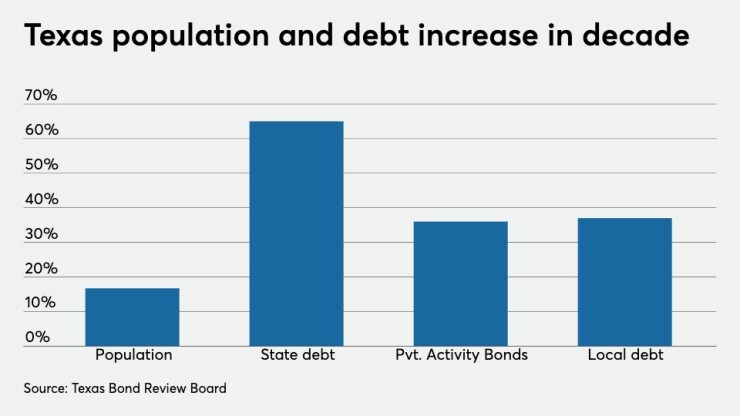Amid a slowing growth rate for the nation, Texas will rank first in population gains when the belated 2020 Census results are revealed, according to the latest estimates.
The Lone Star State added nearly 374,000 residents between July 1, 2019 and the same day in 2020, according to the Census Bureau’s Dec. 22

Since the last census in 2010, Texas is expected to show growth of 16.4% or 4.2 million people. On a percentage basis, Texas’ growth rate is second to Utah’s 17.4%.
In raw numbers, Florida’s addition of 2.9 million people in the decade ranked second. The 15.2% growth rate brought the Sunshine State’s head count to 21.7 million, overtaking New York as the nation’s third-largest state.
From rethinking post-pandemic credit to evaluating the impact of the Biden administration on the municipal bond market, NATIONAL OUTLOOK will gather industry leaders to discuss their predictions and explore key factors driving the market.Register today and join hundreds of leaders in the muni community on March 31st!
The Texas growth comes as the nation’s most populous state of California is showing losses for the first time. The December estimate has the Golden State losing 69,532 people between 2019 and 2020, less than 1% of its 39.4 million people. For the decade, California grew by 5.6% or 2.1 million people.
New York, the fourth most populous state at 19.3 million saw sharp population declines in the past year.
New York joins Illinois, West Virginia, Connecticut, Mississippi and Vermont as states that have lost population since 2010. Sixteen states lost population in the past year, according to the December report.
In the past year, the U.S. population grew by just 0.35% to 329.5 million, according to the estimates. That would be the lowest annual growth rate since at least 1900. The new data also shows that when the 2020 census numbers are announced, the 2010-to-2020 decade growth rate could be the lowest in any decade since the first census was conducted in 1790, according
“These statistics paint a portrait of a nation that is experiencing unprecedented growth stagnation, even before the COVID-19 pandemic hit,” Brookings demographer William Frey wrote. “The exceptionally low growth rate from 2019 to 2020 reflects the pandemic’s impact over part of that year.”
Final results will not be known until the bureau resolves problems with the count that arose amid the pandemic and President Trump’s efforts to alter the process.
After missing its Dec. 31 deadline, the Census Bureau
Riding on the outcome are allotment of seats in Congress and billions of dollars in federal funding to the states and local jurisdictions.
Ten states — Alabama, California, Illinois, Michigan, Minnesota, New York, Ohio, Pennsylvania, Rhode Island and West Virginia — are expected to lose one congressional seat each.
Texas is likely to gain three seats, and Florida is expected to gain two. Arizona, Colorado, Montana, North Carolina and Oregon are expected to gain one seat each.
The federal government will rely on the 2020 census to guide distribution of

The census determines the volume of private activity bonds allotted to each state and sets the pace for issuance of other forms of debt.
Nationally, the $105 per capita state volume cap for PABS rises to $110 per capita for calendar year 2021.
Since 2010, Texas PAB allocation has grown 36% to $3.04 billion, according to the Texas Bond Review Board.
Texas received $101.6 billion in census-guided funding in 2017, according to the
Immigration has played a large part in Texas’ growth, a fact that could affect how its population is counted.
President Trump has issued a memo excluding undocumented residents from the census used for apportionment of Congressional representation. In July, courts shot down a Trump plan to include a citizenship question on the census.
The Supreme Court last month dismissed 6-3 a challenge to Trump’s exclusion of undocumented residents, saying it would be premature to rule before the policy was implemented.
Census results are expected to be delivered on Jan. 23, three days after President-elect Joe Biden’s inauguration.
Trump’s clampdown on immigration, coupled with the pandemic and its economic consequences have further impeded immigration.
The nation’s foreign-born population will experience the smallest growth for any decade since the 1970s, according to Brookings, citing survey data through 2019 showing that foreign-born gains plummeted between the first and third years of the Trump presidency, contributing to a growth slowdown for the entire decade.
As of 2018, Texas’ foreign born population was 4.9 million or 17.2%, according to the Migration Policy Institute. Of those, more than 66% were from Mexico or Latin America.
“Clearly, the nation’s overall growth — and especially that of its younger population — will depend on a return to healthy immigration levels, as immigrants and their children will become the greatest long-term source of youthful growth,” Frey wrote.





